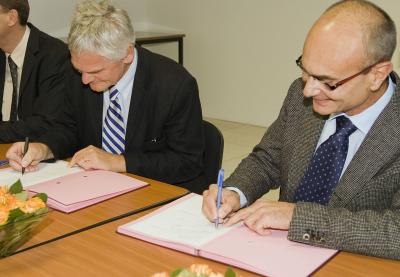- Home
- News
- General News
- The Partnership...
The Partnership for Soft Condensed Matter sees the light
04-12-2009
The science at many ESRF beamlines and ILL instruments will increase significantly over the next years thanks to a new Partnership for Soft Condensed Matter (PSCM). On 27 November 2009, the Directors of the ESRF and the ILL established this collaboration with the signature of a Memorandum of Understanding (MoU). By early 2013, the PSCM will be able to host 20 to 30 scientists and technicians working in 800m2 of laboratory and office space in the new Science Building of the joint ILL/ESRF campus.
Share
In these laboratories, scientists will prepare experiments with highly complex self-assembled and non-equilibrium soft matter systems which cannot be easily transported to Grenoble. Many materials related to nanotechnologies, life sciences, environment and renewable energy are, in fact, soft matter systems. The PSCM will allow samples of these to be prepared in the immediate vicinity of world-class X-ray and neutron sources where their properties can be investigated at many different time- and length scales down to atomic resolution.
|
|
|
Richard Wagner (left), director of ILL, and Francesco Sette, director general of ESRF, signed the MoU on 27 November. |
The planned facilities of the PSCM include instruments for on-site sample preparation, complementary techniques for pre-characterization (e.g. microscopy, rheology, light scattering etc.), complex sample environments (surface and interface techniques, systems in confinement, optical tweezers etc.), advanced data analysis and modeling, and a platform for networking and scientific exchange.
The PSCM will complement research with X-rays and neutrons by attracting academic and industrial partners who will fund and set up laboratory techniques and sample environments to strengthen what the ESRF and the ILL offer themselves. “This partnership approach has been tried and tested with the Partnership for Structural Biology (PSB), established in 2002, which today has become a worldwide model for expanding the range of a synchrotron’s scientific capabilities” says Serge Perez, Director of Research of the ESRF.
The PSCM will benefit the four ESRF soft condensed matter beamlines ID02, ID10A, ID10B, and ID13, as well as beamlines such as ID9B, ID15 and ID16. Also the Collaborating Research Groups at the ESRF, notably BM02, BM16, BM26 and BM32 may take advantage of the new facility. Access will be through peer review and through collaboration agreement when a partner contributes to the staff and equipment of the PSCM.
“Soft matter systems like polymers, liquid crystals and colloids are at the forefront of new advanced materials. The PSCM allows the ESRF and the ILL to play a leading role in addressing the challenges of the 21st century to develop renewable energy sources and to live longer in better health” says Francesco Sette, Director General of the ESRF.
Top image: Soft condensed matter studies include those on polymer fibres.




